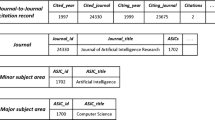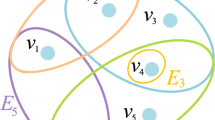Abstract
Knowledge diffusion based on disciplinary citation resembles disease propagation through actual contact. Inspired by the epidemic spread model, the study classifies disciplines from the viewpoint of knowledge diffusion into five states: knowledge recipient disciplines (S), potential knowledge diffusion disciplines (E), knowledge diffusion disciplines (I), knowledge skeptic disciplines (Z), and knowledge immune disciplines (R). The classifications of disciplines can change from one state to another at a rate of α, β, ω, γ, θ or μ. As a result, evolution rules for knowledge diffusion in the disciplinary citation network are created, and the knowledge diffusion SEIZRS model of differential dynamics in the disciplinary citation of a non-uniform network is formed, followed by a comparative analysis between the SEIZRS model and the classic SIR model. Next, the evolution of knowledge diffusion and the influence of state transition parameters on it are discussed to reveal the dynamic mechanism of knowledge diffusion in the disciplinary citation network. Research has shown that the latent mechanism, skeptical mechanism, and feedback mechanism of knowledge introduced in this study can effectively reveal the dynamic mechanism of knowledge diffusion in the disciplinary citation network. The knowledge diffusion state evolution of disciplines in the disciplinary citation network is affected by both the knowledge diffusion evolution states and the relative citation weight (knowledge contact intensity) of neighboring disciplines. Moreover, changes in state transition parameters have different effects on the evolution of knowledge diffusion.











Similar content being viewed by others
References
Anderson, R. M., & May, R. M. (1991). Infectious diseases of humans: Dynamics and control. Oxford University Press.
Bettencourt, L. M. A., Cinron-Arias, A., Kaiser, D. I., & Castillo-Chavez, C. (2006). The power of a good idea: Quantitative modeling of the spread of ideas from epidemiological models. Physica A: Statistical Mechanics and Its Applications, 364, 513–536.
Cowan, R., & Jonard, N. (2004). Network structure and the diffusion of knowledge. Journal of Economic Dynamics & Control, 28, 1557–1575.
Gao, X., & Guan, J. C. (2012). Network model of knowledge diffusion. Scientometrics, 90(3), 749–762.
Gurley, N., & Johnson, D. K. N. (2017). Viral economics: an epidemiological model of knowledge diffusion in economics. Oxford Economic Papers—New Series, 69(1), 320–331.
Huang, H., Chen, Y. H., & Ma, Y. F. (2021). Modeling the competitive diffusions of rumor and knowledge and the impacts on epidemic spreading. Applied Mathematics and Computation, 388, 125536.
Jang, J., Ju, X., Ryu, U., & Om, H. (2019). Coevolutionary characteristics of knowledge diffusion and knowledge network structures: A GA-ABM model. JASSS-the Journal of Artificial Societies and Social Simulation, 22(3), 3.
Kiss, I. Z., Broom, M., Craze, P. G., & Rafols, I. (2009). Can epidemic models describe the diffusion of topics across disciplines? Journal of Informetrics, 4(1), 74–82.
Li, J. J., Zhang, Y. M., Man, J. Y., Zhou, Y., & Wu, X. J. (2017). SISL and SIRL: Two knowledge dissemination models with leader nodes on cooperative learning networks. Physica A: Statistical Mechanics and Its Applications, 468, 740–749.
Liu, J. S., & Kuan, C. H. (2016). A new approach for main path analysis: Decay in knowledge diffusion. Journal of the American Society for Information Science and Technology, 67(2), 465–476.
Luo, S. L., Du, Y. Y., Liu, P., Xuan, Z. G., & Wang, Y. Z. (2015). A study on coevolutionary dynamics of knowledge diffusion and social network structure. Expert Systems with Applications, 42(7), 3619–3633.
Ma, F., & Wu, Y. S. (2009). A survey study on motivations for citation. Journal of Intelligence, 28(6), 9–14.
Ozel, B. (2010). Scientific collaboration networks: Knowledge diffusion and fragmentation in Turkish management academia. Istanbul Bilgi University.
Reagans, R., & McEvily, B. (2003). Network structure and knowledge transfer: The effects of cohesion and range. Administrative Science Quarterly, 48(2), 240–267.
Tortoriello, M., Reagans, R., & McEvily, B. (2012). Bridging the knowledge gap: The influence of strong ties, network cohesion, and network range on the transfer of knowledge between organizational units. Organization Science, 23(4), 1024–1039.
Wang, J. P., Guo, Q., Yang, G. Y., & Liu, J. G. (2015). Improved knowledge diffusion model based on the collaboration hypernetwork. Physica A: Statistical Mechanics and Its Applications, 428, 250–256.
Wang, X. G. (2013). Forming mechanisms and structures of a knowledge transfer network: Theoretical and simulation research. Journal of Knowledge Management, 17(2), 278–289.
Wang, X. J., & Liu, H. L. (2007). An analysis of knowledge chain based on social network theory. Journal of Intelligence, 2, 18–21.
Wu, H. Q., Xue, X. L., Zhao, Z. B., Wang, Z. Y., Shen, G. Q., & Luo, X. W. (2020). Major knowledge diffusion paths of megaproject management: A citation-based analysis. Project Management Journal, 51(3), 242–261.
Xu, L., Ding, R. G., & Wang, L. (2022). How to facilitate knowledge diffusion in collaborative innovation projects by adjusting network density and project roles. Scientometrics, 127(3), 1353–1379.
Xu, Y., & Jin, J. B. (2013). The development of social media and its social impact. Media, 6, 10–13.
Yang, J. Q., & Liu, Z. F. (2021). The effect of citation behaviour on knowledge diffusion and intellectual structure. Journal of Informetrics, 16(1), 101225.
Ye, Y. D., De Moortel, K., & Crispeels, T. (2020). Network dynamics of Chinese university knowledge transfer. Journal of Technology Transfer, 45(4), 1228–1254.
Yu, D. J., & Pan, T. X. (2021). Tracing knowledge diffusion of TOPSIS: A historical perspective from citation network. Expert Systems with Applications, 168, 114238.
Yu, D. J., & Sheng, L. B. (2020). Knowledge diffusion paths of blockchain domain: The main path analysis. Scientometrics, 125(1), 471–497.
Yue, Z. H., Xu, H. Y., & Yuan, G. T. (2021). Modeling knowledge diffusion in the disciplinary citation network based on differential dynamics. Proceedings of the 18th International Conference on Scientometrics and Informetrics, 1277–1288.
Yue, Z. H., Xu, H. Y., Yuan, G. T., & Pang, H. S. (2019). Modeling study of knowledge diffusion in scientific collaboration networks based on differential dynamics: A case study in graphene field. Physica A: Statistical Mechanics and Its Applications, 524, 375–391.
Zhu, H., & Ma, J. (2018). Knowledge diffusion in complex networks by considering time-varying information channels. Physica A: Statistical Mechanics and Its Applications, 494, 225–235.
Zhu, H. M., Wang, Y. M., Yan, X., & Jin, Z. (2022). Research on knowledge dissemination model in the multiplex network with enterprise social media and offline transmission routes. Physica A: Statistical Mechanics and Its Applications, 587, 126468.
Acknowledgements
This research is supported by the National Natural Science Foundation of China (Grant No. 71704063) and the Tai Shan Scholar Foundation in Shandong province (2021–2025). The paper is an extended version of the ISSI2021 conference paper (Yue et al., 2021).
Funding
This study was supported by National Natural Science Foundation of China (Grant No. 71704063).
Author information
Authors and Affiliations
Corresponding author
Ethics declarations
Conflict of interest
The authors declare that they have no conflict of interest.
Rights and permissions
Springer Nature or its licensor holds exclusive rights to this article under a publishing agreement with the author(s) or other rightsholder(s); author self-archiving of the accepted manuscript version of this article is solely governed by the terms of such publishing agreement and applicable law.
About this article
Cite this article
Yue, Z., Xu, H., Yuan, G. et al. Modeling knowledge diffusion in the disciplinary citation network based on differential dynamics. Scientometrics 127, 7593–7613 (2022). https://doi.org/10.1007/s11192-022-04491-7
Received:
Accepted:
Published:
Issue Date:
DOI: https://doi.org/10.1007/s11192-022-04491-7




